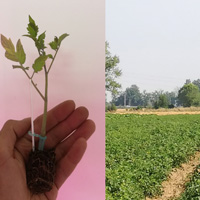Biostimulants and cherry rootstock increased tomato fruit yield and quality in sustainable farming systems

Accepted: 28 March 2020
Appendix: 87
HTML: 101
All claims expressed in this article are solely those of the authors and do not necessarily represent those of their affiliated organizations, or those of the publisher, the editors and the reviewers. Any product that may be evaluated in this article or claim that may be made by its manufacturer is not guaranteed or endorsed by the publisher.
Nowadays one of the main challenges in agriculture is to increase crop yield and quality in a sustainable way. Organic farming system (OFS) is considered more eco-friendly than the conventional farming system (CFS). However, cash crops showed a reduced yield when cultivated in OFS, and among them processing tomato reported the highest yield gap between OFS and CFS. Therefore, the objective of this study was to investigate, both in greenhouse and field experiments, the combined effects of a cherry rootstock, genotype ‘Tomito’, and the applications of different microbial biostimulants (single species and consortia). The agronomic performance of a commercial processing tomato genotype, ‘H3402’, was assessed in order to increase fruit yield and quality in sustainable farming systems. In greenhouse experiment, the use of ‘Tomito’ as rootstock highlighted both the highest plant height (35 cm) and leaf chlorophyll content (25.20), while plants inoculated with A. brasiliensis showed the highest number of flowers (4.5). In field experiment, the combined use of grafting and microbial biostimulants increased marketable (on average 2.3 kg plant–1) and total yields (on average 2.5 kg plant–1) in comparison with the genotype ‘H3402’. All the investigated treatments reduced the number of fruits affected by blossom-end rot (on average –4.7 fruits plant–1), and A. brasiliensis also improved the fruit solid soluble content, recording values of 6.23 °Brix and 3.54 of Brix t ha–1.
Highlights
- In the greenhouse experiment, the use of the rootstock ‘Tomito’ increased the leaf chlorophyll content and plant height
- In the greenhouse experiment, Azospirillum brasiliensis sp 245 induced early flowering
- In the field experiment, the use of rootstock ‘Tomito’ increased the number of fruits in comparison with non-grafted plants
- Grafted plants inoculated with Paraburkholderia graminis or the bacterial consortium showed the highest total yield
How to Cite
PAGEPress has chosen to apply the Creative Commons Attribution NonCommercial 4.0 International License (CC BY-NC 4.0) to all manuscripts to be published.

 https://doi.org/10.4081/ija.2020.1553
https://doi.org/10.4081/ija.2020.1553



